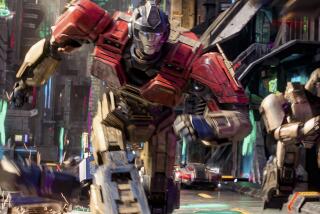Many moving parts snap into place in ‘The Lego Movie’
With Batman, Gandalf and Luke Skywalker all making appearances — and, of course, with constant references to the titular toy — “The Lego Movie” may be one of the biggest brand barrages Hollywood has unleashed on the American filmgoing public in recent memory.
With an undercurrent of anti-totalitarianism, a suggestion that big corporations keep us numb with empty entertainment and even self-mocking references to dud Lego products, the film also may be one of the more meta and subversive movies Hollywood has unleashed on the American filmgoing public in recent memory.
It was only a matter of time. With “The Lego Movie,” the film business has come up with the first-ever postmodern toy movie. And it certainly has a unique construction.
FULL COVERAGE: Winter Movie Sneaks
“It’s an anti-corporate movie that’s all about a huge corporation, and that’s a funny synthesis,” said Chris Miller, one of the film’s writer-directors.
“My dream is to have terrible undergraduate term papers written about the movie,” said Phil Lord, another of the film’s writer-directors.
“The Lego Movie” (an early, cheeky subtitle was “The Piece of Resistance”) offers an elaborate, ahem, structure.
The plot for the animated film, which arrives in theaters Feb. 7 and marks the Danish toy giant’s first turn on the big screen, centers on the rule-following Lego mini-figure Emmet (voiced by Chris Pratt) who is improbably chosen for an epic quest. He soon meets WyldStyle (Elizabeth Banks), a punky type who believes in maverick thinking and imaginative play. When the evil leader Lord Business (Will Ferrell) cooks up a plan for world domination, the odd couple unite to stop him, encountering Batman (Will Arnett) and other branded Lego characters along the way.
The visuals have been built with a certain aesthetic in mind. Characters look and move as Lego characters do in real life, not according to a CGI film’s typical anything-goes rules of motion. Objects like water are made up of bricks.
PHOTOS: Billion-dollar movie club
And in the tradition of crosstown competitor DreamWorks Animation, Warner Bros. has ensured plenty of adult references; for every kid-friendly pun (“Rest in pieces”) there’s a sly Siri joke.
But if story or comedy aren’t what you look for in an animated release, perhaps you’ll want to see “The Lego Movie” for its anti-corporate messaging?
There are derisive nods to fast-food chains, portrayals of a reality TV show that’s been created to anesthetize an electorate and even, in Lord Business’ interest in keeping various Lego worlds separate, anti-immigration overtones.
Do the filmmakers (who also include co-director Chris McKay, original writers Dan and Kevin Hageman and lead producer Dan Lin) see a contradiction in the questioning of capitalism amid the display of big corporate brands (many are owned by WB, others are licensed) and marketing partners (there will be Happy Meals)? Or feel odd making a movie about painting outside the lines on behalf of the giant conglomerates typically associated with staying in them?
“We are trying to play it from both sides,” Lord said.
“It’s actually what Lego is about. The idea with many of the kits is that you can follow the instructions and have it look exactly like it does on the box, or you can go your own way and build it so that it looks the way you want it to look,” Miller said. “We’re making a movie that shows there’s no one way to do things. And hopefully making people laugh doing it.” (He and Lord previously teamed up on the “Cloudy with a Chance of Meatballs” and “21 Jump Street” franchises.)
PHOTOS: Greatest box office flops
And what about corporate partners — did they not have any objections to the self-jabs?
“There was some of that,” Miller said.
“We needed to do a lot of reminding with partners that this is a movie so supportive of the brand you can afford to wink at things,” Lord said. “We felt like, if we couldn’t do that kind of thing, it wasn’t worth doing a Lego movie.”
The film’s, er, piece de resistance is a third-act turn to the postmodern that would make Derrida proud. It’s also a conclusion that explains a lot about the story that preceded it. “We wanted an ending that answers a lot of the questions people had before,” Lord said.
In other words, something that helps it all click into place.
More to Read
Only good movies
Get the Indie Focus newsletter, Mark Olsen's weekly guide to the world of cinema.
You may occasionally receive promotional content from the Los Angeles Times.











